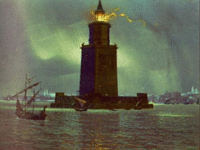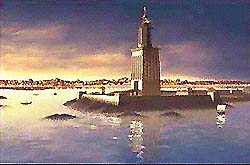On that night, Alexander the Great settles on the shores of the city that will become Alexandria. During his sleep he gets suddenly awoken by an old gray-haired man.
The old man points the island of Pharos and vanishes into thin air. Alexander looks at the island and immediately realises the strategic importance of this place...

After Alexander's death, a new dynasty of pharaohs takes the power in Egypt; The Ptolemies. This new dynasty was Greek but to keep the unity of Egypt, they also kept the Egyptian traditions.
Ptolemy I
wanted to fulfill Alexander's dream and started the construction of Alexandria..
The city became rapidly a very important city. Following Alexander's vision,
Ptolemy I also started the construction of a gigantic lighthouse to protect
the ships against the dangerous Alexandrian shores. This way, Alexandria
would become a commercial centre between the Eastern world and the Western
world. Ptolemy I never saw his project complete because he died before
the lighthouse was finished..
The lighthouse is completed under Ptolemy II, pharaoh of Egypt. The lighthouse
consisted in three different levels. The lighthouse, located on the island
of Pharos, was about 120 meters high, probably one of the highest construction
ever built during the Antiquity. The fire burning at the top of it could
be seen at 55 km around. All merchants coming toAlexandria were struck
by the magnificence of this building. The lighthouse rapidly became a
symbol of the city and also a source of inspiration for painters and sculptors.
The lighthouse became one of the seven wonders of the ancient world.
Unfortunately, several heartquakes damaged repeatedly the lighthouse and
a part of the antique city. The top floors fell first into the sea. Later
(supposedly in the 14th century), the last standing part of the building
also fell into the sea. The lighthouse became a myth because nobody could
really prove it had existed, excepted people who had seen it. After the
moslim invasion, the Qaytbay fort was built where the Pharos stood destroying
any evidence of its existence.
In 96, the Egyptian government decided to build a new concrete dike in
Alexandria's bay to protect Qaytbay fort from dangerous waves. Archaelogists
immediately protested because they knew that a part of the Antique city
was still under the water. After long negociations, a team of French archaelogists
got the authorisation to search the sea bottoms. They rapidly found a
incredibly amount of objects like sphynxes, statues, columns dating from
Ramses II until the Ptolemy period. French archeologists were also looking
for some evidence that would prove the existence of the lighthouse. They
rapidly found huge blocks in the water, too big and too heavy to be part
of an old temple or any other construction. The myth became reality ...
